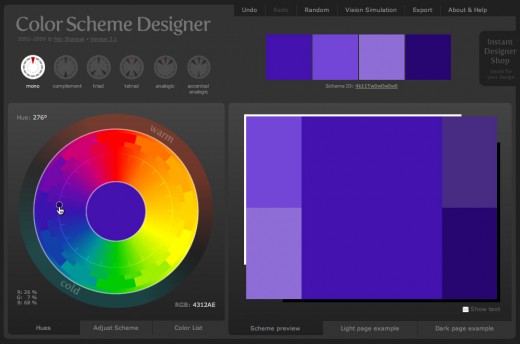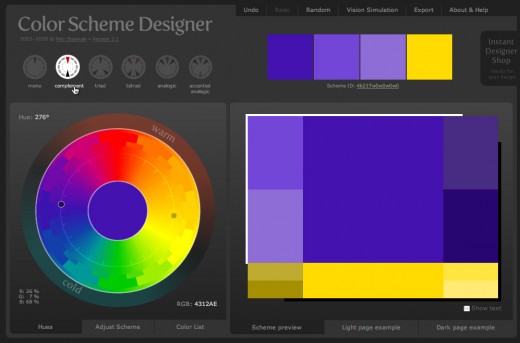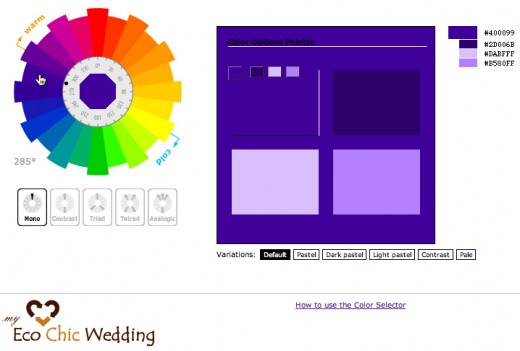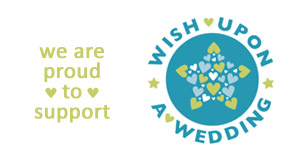This post is the second installment of a two-part series on using online tools to help decide on a color scheme for your wedding. If you haven’t already, you should first read yesterday’s post.
Yesterday we learned how to generate sample palettes by uploading photos of our location, wedding item, or any other image, to an online Palette Generator. It’s a great way to brainstorm and get some initial ideas on what our main or even supporting colors might be.
Color Scheme Designers/Selectors
Palette generators can give you a sense of a color palette from the picture of a location or item. But by using a full-fledged color scheme designer, you can make the leap to truly massaging and flexing a palette. These tools are great for building color schemes around one or more main colors, and seeing how different colors work together. It’s another graphics designer tool that can be immensely helpful in your wedding color search.
Color Scheme Designer (colorschemedesigner.com) is a free tool that is very powerful and flexible. At its simplest, you can select a primary color from the color wheel (or enter in color codes or RGB values) and see a monochromatic generated palette. Adjust the hue, brightess, and contrast to shift the shades. But things get really interesting when you start working with different color scheme types, like complements and tetrads. What the heck are those? Well, changing the color scheme type will give you a different palette based on your primary–or base–color.

Change the color scheme type to get a different type of palette. A complement palette, for example, will include an accent color that is a complementary opposite of the base color. It gives you a feel for contrasting colors that work together.
The various types of color schemes the tool will generate are as follows:
![]() Monochromatic: based on a single color tint, and varies the saturation and brightness to achieve the different shades in the palette. Simple and eye-pleasing.
Monochromatic: based on a single color tint, and varies the saturation and brightness to achieve the different shades in the palette. Simple and eye-pleasing.
![]() Complement: The base color and its variations are supplemented with a contrasting color on the opposite side of the color wheel. Vibrant and energetic.
Complement: The base color and its variations are supplemented with a contrasting color on the opposite side of the color wheel. Vibrant and energetic.
![]() Triad: The base color is supplemented with two complementing colors that are sometimes less jarring than the single direct contrast in the complement scheme. Still vibrant and energetic.
Triad: The base color is supplemented with two complementing colors that are sometimes less jarring than the single direct contrast in the complement scheme. Still vibrant and energetic.
![]() Tetrad: Made up of two base colors and their complements. Be careful with this one: all that contrast results in a very aggressive color scheme.
Tetrad: Made up of two base colors and their complements. Be careful with this one: all that contrast results in a very aggressive color scheme.
![]() Analogic: Made up of a base color and two related colors. Usually provides a clean, uniform look.
Analogic: Made up of a base color and two related colors. Usually provides a clean, uniform look.

Export your color scheme
If you choose to stray from the monochromatic, think of creative ways to integrate any contrasting colors you adopt into your wedding details. That single contrasting color in the complement scheme, for example, might be a great accent color to use sparingly in your bouquet, favors, and decor.
You can also export your color scheme–to Adobe Photoshop for further tinkering, for example–or to an HTML or CSS stylesheet. But the Color Scheme Designer itself really does have all the features you need to explore and narrow down the color scheme choice for your wedding.
A similar tool, this one geared specifically towards wedding planning, is available at My Eco Chic Wedding (myecochicwedding.com).
It has similar features as Color Scheme Designer, as you can see below, though it lacks some of the features and functionality. One item it does offer is a simple menu beneath the palette viewer that lets you adjust the palette for pastel, dark pastel, light pastel, contrast, and pale. It makes for an easy way to quickly adjust the overall shade of the generated palette.
So what do these tools get you? Again, just as we did yesterday, we’re brainstorming here. The idea is to see what colors grab you, and which–if any–work together that you’d like to adopt into a color scheme for your wedding. Work with your sweetheart to settle on a main color and one or two supporting colors that you can rely on throughout your wedding planning. There’s no solid rule for how many colors you use, though the most common wedding color schemes contain two or three colors max…any more and things might start looking cluttered. The color scheme designer should let you play and tinker with the colors until you get your selections down pat.
Now go forth, and conquer your color quest. I hope these tools will be a help in narrowing down your search. Good luck!










The Google image search can also be a great way to help you research your ideal wedding colour scheme. Search for something like ‘wedding accessories’ and then use the colour palette on the left to choose a particular colour. The results will then be refined to show images that primarily contain that colour.
Not only is it a great way to help you with your wedding colour scheme, but I’m sure you’ll also stumble upon some great ideas for wedding accessories too!